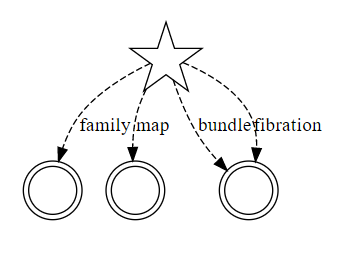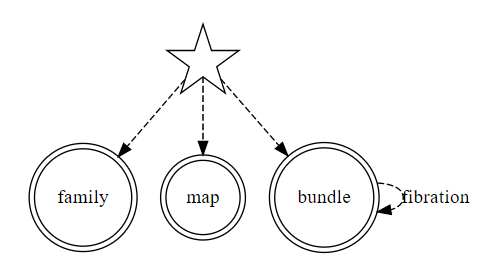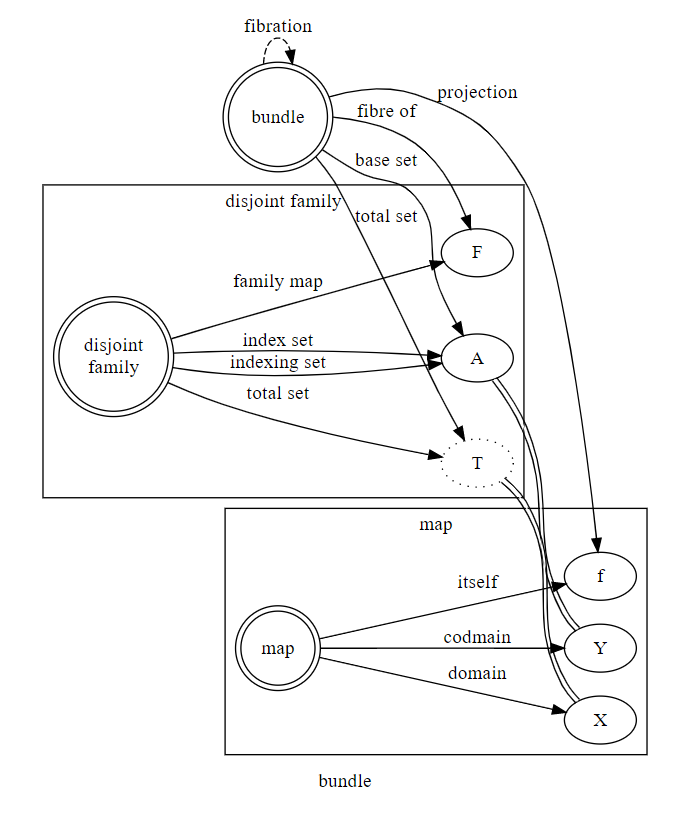ある文脈では、「射影」は直積の射影ではなく全射でさえない写像を意味する。つまり、「射影」と「写像」は同義語。こういう“文脈”をどうしたら(ある程度)形式化できるだろうか?
内容:
記述方法
well-traind people のあいだならコミュニケーション可能だと信じている。
- 半形式的記述を用いる。
と
はブロック(ひとかたまりの記述)の区切りが分かりにくいときに使う。ハッキリと区切れるときは使う必要はない。
- ブロックは名前空間を持ち、ブロック内で宣言された名前はブロック・ローカルになる。
- ブロック自体の名前はカレント(今の話題)のグローバル名前空間に入る。
- 「今の話題」は、プログラミング言語でいうモジュールやパッケージになるだろう。
ファミリー
ファミリー:
名前 indexing set の修飾付き名〈qualified name〉は以下のようになる(どれも使える)。階層の区切りはスラッシュを使う(ドットは他の目的で使いそうだから)。
- その他は省略
もちろん日本語でもよい。スラッシュの代わりに太字の「の」を使ってみる。
- 族の
- 族のインデックス集合〈indexing set〉
- 族のインデックス集合〈index set〉
- インデックス付き集合族の
- インデックス付き集合族のインデックス集合〈indexing set〉
- インデックス付き集合族のインデックス集合〈index set〉
- その他は省略
無共分ファミリー:
ファミリー → 無共分ファミリー:
写像(冗長な定義):
写像 → 無共分ファミリー:
無共分ファミリー → 写像:
無共分ファミリーと写像の同型:
自然言語で一言でいえば:
- 無共分ファミリーという概念と写像という概念は、事実上同じである。
バンドル
バンドル:
バンドルという概念は、make-map-of-disjoint-family, make-family-of-map で結ばれた族と写像の両方を一度に考えている。
写像からバンドルを一意に構成でき、ファミリーからもバンドルを一意に構成できる。つまり、
- 写像、無共分ファミリー、バンドルという3つの概念は、事実上同じである。
- 任意のファミリーは無共分化できるので、写像、任意のファミリー、バンドルという3つの概念も、ほぼ同じである。
全射バンドル:
次のように書ける。
全射バンドルの言い換え:
日本語に翻訳すると:
はバンドルだとして、
が全射バンドルであるとは、
のベース集合の任意の要素に対してその要素のファイバーが空ではないこと。
次は明らかだろう。
- 全射写像、値が空集合にならない無共分ファミリー、全射バンドルという3つの概念は、事実上同じである。
名前構造
グローバル名前空間にグローバル・ルートノードがあり、ルートから名指し〈naming | designation by name〉の有向辺をたどって各種概念の名前に到達できる。
- グローバルルートは星印
- 構造(の概念)は二重丸
- 構造の名指しは破線矢印
- 名前は必ず有向辺(名指しの辺)に付く。ノードには付かない!

- 略記として、名前のひとつをノードに付けてもいい。が、あくまで略記。名前は必ず有向辺(名指しの辺)に付く。
- 別名は自己ループ辺として書いたよい。が、実際はグローバルルートからの有向辺(名指しの辺)に別名が付く。

- グローバルルートからの有向辺(名指しの辺)を省略してよい。
- あくまで省略。略記で構造を誤解しないように。

バンドルの名前構造は次のようになる。詳細は図の後に。

- 構造のノード(二重丸)は名前空間を持つ。
- 構造の名前空間には、その構造自体を表すローカルルートがある。
- ローカルルートから出る名指しの辺(実線矢印)には、構成素名〈役割名〉が乗る。
- 構成素は楕円ノード。
- バンドルの名前空間内に、無共分ファミリーの名前空間と写像の名前空間(のコピー達)が包含〈containment〉される。
- 写像の余域とファミリーのインデックス集合は同一なので、二重線(イコール)で結ばれる。張り合わさって重なると思ってよい。
- 点線のノード「トータル集合」はもとの無共分ファミリーの名前空間にはないが、追加した。
- 写像の域とファミリーのトータル集合は同一なので、二重線(イコール)で結ばれる。
- 「射影」や「底集合」は、バンドルという構造の構成素名である。
- バンドルの構成素名「射影」は、写像の構成素名「それ自身」と同じ概念をさす。
- これが、「ある文脈では、「射影」と「写像」が同義語となる」メカニズム。
さらに同義語
Graphvizソース
/* global naming official */ digraph { global[shape=star, label=""] family[shape="doublecircle", label=""] map[shape="doublecircle", label=""] bundle[shape="doublecircle", label=""] global -> family[style=dashed,label="family"] global -> map[style=dashed,label="map"] global -> bundle[style=dashed,label="bundle"] global -> bundle[style=dashed,label="fibration"] }
/* global naming shorthand */ digraph { global[shape=star, label=""] family[shape="doublecircle"] map[shape="doublecircle"] bundle[shape="doublecircle"] global -> family[style=dashed] global -> map[style=dashed] global -> bundle[style=dashed] bundle -> bundle[style=dashed, label="fibration"] }
/* global naming abbrev */ digraph { family[shape="doublecircle"] map[shape="doublecircle"] bundle[shape="doublecircle"] bundle -> bundle[style=dashed, label="fibration"] }
```graphviz /* name structure of bundle */ digraph { rankdir = LR label="bundle" bundle[shape=doublecircle] bundle -> bundle[label="fibration", style=dashed] subgraph cluster_fam { label="disjoint family" family[shape=doublecircle, label="disjoint\n family"] famMap[label="F"] ind[label="A"] tot[label="T", style=dotted] family -> ind[label="indexing set"] family -> ind[label="index set"] family -> famMap[label="family map"] family -> tot[label="total set"] } subgraph cluster_map { label="map" map[shape=doublecircle] dom[label="X"] cod[label="Y"] it[label="f"] map -> dom[label="domain"] map -> cod[label="codmain"] map -> it[label="itself"] } ind -> cod[color="black:white:black";arrowhead=non] tot -> dom[color="black:white:black";arrowhead=non] bundle -> it[label="projection"] bundle -> ind[label="base set"] bundle -> tot[label="total set"] bundle -> famMap[label="fibre of"] }